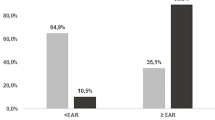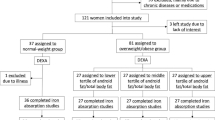Abstract
Objective
To examine the impact of a body fat content on the concentration of a serum prohepcidin, iron metabolism parameters and inflammation markers in elderly patients with microcytic or normocytic anemia.
Design
Clinical study with biochemical and anthropometric measurements.
Subjects
Fifty two elderly patients (19 male, 33 female) with anemia, 65–91 years of age.
Measurements
Prohepcidin, ferritin, soluble transferrin receptor, erythropoietin and interleukin-6 were measured using commercially available ELISA kits. Iron, TIBC, transferrin, C-reactive protein and complete blood count were assayed using standard laboratory methods. Body fat content, fat distribution and protein nutrition state parameters were assessed by means of anthropometry.
Results
Mean serum prohepcidin levels were significantly higher in patients with high body fat content in comparison to patients with normal body fat content (224,85 vs 176,6 ng/ml). Prohepcidin levels of the elderly patients with anemia were positively correlated with biceps, subscapular and suprailiac skinfold thickness or body fat mass percentage. In our study serum prohepcidin levels do not correlate with any iron parameters or inflammation markers.
Conclusion
Summing up, the results of this study indicate that increased prohepcidin concentration, observed in obese elderly patients with anemia, may play an important role in iron deficiency development.
Similar content being viewed by others
References
Guralnik JM, Ershler WB, Schrier SL, et al (2005) Anemia in the Elderly: A Public Health Crisis in Hematology. Hematology 1: 528–532
Balducci L (2003) Epidemiology of Anemia in the Elderly: Information on Diagnostic Evaluation. J Am Geriatr Soc 51: 2–9
Bekri S, Gual P, Anty R, et al (2006) Increased adipose tissue expression of hepcidin in severe obesity is independent from diabetes and NASH. Gastroenterol 131: 691–693
Chung B, Matak P, McKie AT, et al (2007) Leptin Increases the Expression of the Iron Regulatory Hormone Hepcidin in HuH7 Human Hepatoma. Cells J Nutr 137: 2366–2370
Farahani P, Chiu S, Bowlus CL, et al (2004) Obesity in BSB mice is correlated with expression of genes for iron homeostasis and leptin. Obes Res 12:191–204
Lecube A, Carrera A, Losada E, et al (2006) Iron deficiency in obese postmenopausal women. Obesity 14: 1724–1730
Nead KG, Halterman JS, Kaczorowski JM, et al (2004) Overweight children and adolescents: a risk group for iron deficiency. Pediatrics 114: 104–108
Pinhas-Hamiel O, Newfield RS, Koren I, et al (2003) Greater prevalence of iron deficiency in overweight and obese children and adolescents. Int J Obes Relat Metab Disord 27: 416–418
Yanoff LB, Menzie CM, Denkinger B, et al (2007) Inflammation and iron deficiency in the hypoferremia of obesity. Int J Obes (Lond) 9: 1412–1419
Olivares M, Hertrampf E, Capurro MT, et al (2000) Prevalence of anemia in elderly subjects living at home: role of micronutrient deficiency and inflammation. Eur J Clin Nutr. 54: 834–839
Lago F, Dieguez C, Gómez-Reino J, et al (2007) Adipokines as emerging mediators of immune response and inflammation. Nat Clin Pract Rheumatol 3: 716–724
Lago F, Dieguez C, Gomez-Reino J, et al (2007) The emerging role of adipokines as mediators of inflammation and immune responses. Cytokine Growth Factor Rev 18: 313–325
Rosen ED, Spiegelman BM (2006) Adipocytes as regulators of energy balance and glucose homeostasis. Nature 444: 847–853
Nicolas G, Chauvet C, Viatte L, et al (2002) The gene encoding the iron regulatory peptide hepcidin is regulated by anemia, hypoxia, and inflammation. J Clin Invest 110: 1037–1044
Park CH, Valore EV, Waring AJ, et al (2001) Hepcidin, a urinary antimicrobial peptide synthesized in the liver. J Biol Chem 276: 7806–7810
Krause A, Neitz S, Magert HJ, et al (2000) LEAP-1, a novel highly disulfide-bonded human peptide, exhibits antimicrobial activity. FEBS Lett 480: 147–150
Hunter HN, Fulton DB, Ganz T, et al (2002) The solution structure of human hepcidin, a peptide hormone with antimicrobial activity that is involved in iron uptake and hereditary hemochromatosis. J Biol Chem 277: 37597–37603
Benedict C, Ghio AJ, Gehring H, et al (2007) Transient hypoxia and downregulation of circulating prohepcidin concentrations in healthy young men. Haematologica 92: 125–126
Leung PS, Srai SK, Mascarenhas M, et al (2005) Increased duodenal iron uptake and transfer in a rat model of chronic hypoxia is accompanied by reduced hepcidin expression. Gut 54: 1391–1395
Hadley KB, Johnson LK, Hunt JR. (2006) Iron absorption by healthy women is not associated with either serum or urinary prohepcidin. Am J Clin Nutr 84: 150–155
Knutson MD, Oukka M, Koss LM, et al (2005) Iron release from macrophages after erythrophagocytosis is up-regulated by ferroportin 1 overexpression and down-regulated by hepcidin. Proc Natl Acad Sci U S A 102: 1324–1328
Laftah AH, Ramesh B, Simpson RJ, et al (2004) Effect of hepcidin on intestinal iron absorption in mice. Blood 103: 3940–3944
Rivera S, Liu L, Nemeth E, et al (2005) Hepcidin excess induces the sequestration of iron and exacerbates tumor-associated anemia. Blood 105: 1797–1802
Rivera S, Nemeth E, Gabayan V, et al (2005) Synthetic hepcidin causes rapid dosedependent hypoferremia and is concentrated in ferroportin-containing organs. Blood 106: 2196–2199
Weinstein DA, Roy CN, Fleming MD, et al (2002) Inappropriate expression of hepcidin is associated with iron refractory anemia: implications for the anemia of chronic disease. Blood 100: 3776–3781
Yamaji S, Sharp P, Ramesh B, et al (2004) Inhibition of iron transport across human intestinal epithelial cells by hepcidin. Blood 104: 2178–2180
Lainé F, Jouannolle A, Morcet J, et al (2005) Phenotypic expression in detected C282Y homozygous women depends on body mass index. J Hepatol 43: 1055–1059
Tussing-Humphreys LM, Nemeth E, Fantuzzi G, et al (2010) Elevated systemic hepcidin and iron depletion in obese premenopausal females. Obesity 18: 1449–1456
Yanoff LB, Menzie CM, Denkinger B, et al (2007) Inflammation and iron deficiency in the hypoferremia of obesity. Int J Obes 31: 1412–1419
Miraglia del Giudice E, Santoro N, Amato A, et al (2009) Hepcidin in obese children as a potential mediator of the association between obesity and iron deficiency. J Clin Endocrinol Metab 94: 5102–5107
Richardson MW, Ang L, Visintainer PF, et al (2009) The Abnormal Measures of Iron Homeostasis in Pediatric Obesity Are Associated with the Inflammation of Obesity. Int J Pediatr Endocrinol 2009: 713269.
World Health Organization (1972) Nutritional anaemias: report of a WHO group of experts. WHO, Geneva
Malinowski A, Bo_i_ow W (1997) Podstawy antropometrii. Metody, techniki, normy. PWN, Warszawa - _ód_
World Health Organization (1995) Physical status: the use and interpretation of anthropometry. Technical Report Series 854. WHO, Genewa,.
Gibson RS (2003) Principles of nutritional assessment. Oxford University Press, New York
Heymsfield SB, Williams PJ (1998) Nutritional assessment by clinical and biochemical methods. In: Shils ME, Young V R Lea Febiger (eds) Modern nutrition in health and disease, Ed. 7th; Ch. 45. Philadelfia, pp 817–860
Szczygie_ B (2001) Metody oceny stanu od_ywienia chorych w szpitalach. In: Dzieniszewski J, Szponar L, Szczygie_ B, Socha J (eds) Podstawy naukowe _ywienia w szpitalach, I__, Warszawa, pp 324–339
Nicolas G, Bennoun M, Porteu A, et al (2002) Severe iron deficiency anemia in transgenic mice expressing liver hepcidin. Proc Natl Acad Sci USA 99: 4596–4601
Merle U, Fein E, Gehrke SG, et al (2007) The iron regulatory peptide hepcidin is expressed in the heart and regulated by hypoxia and inflammation. Endocrinology 148: 2663–2668
Author information
Authors and Affiliations
Corresponding author
Rights and permissions
About this article
Cite this article
Przybyszewska, J., Zekanowska, E., Kedziora-Kornatowska, K. et al. Prohepcidin and iron metabolism parameters in the obese elderly patients with anemia. J Nutr Health Aging 15, 259–264 (2011). https://doi.org/10.1007/s12603-010-0320-6
Received:
Accepted:
Published:
Issue Date:
DOI: https://doi.org/10.1007/s12603-010-0320-6




